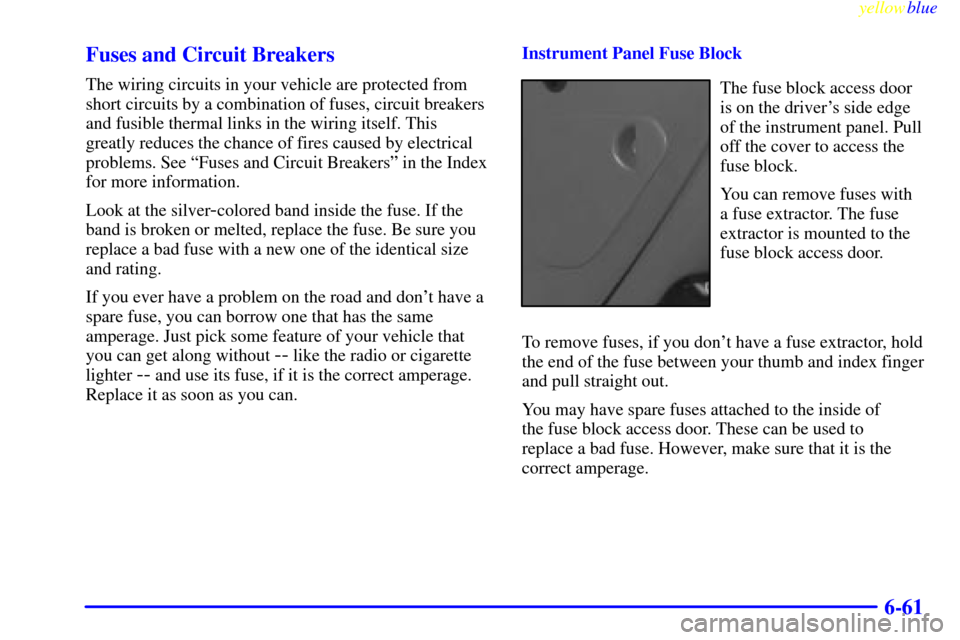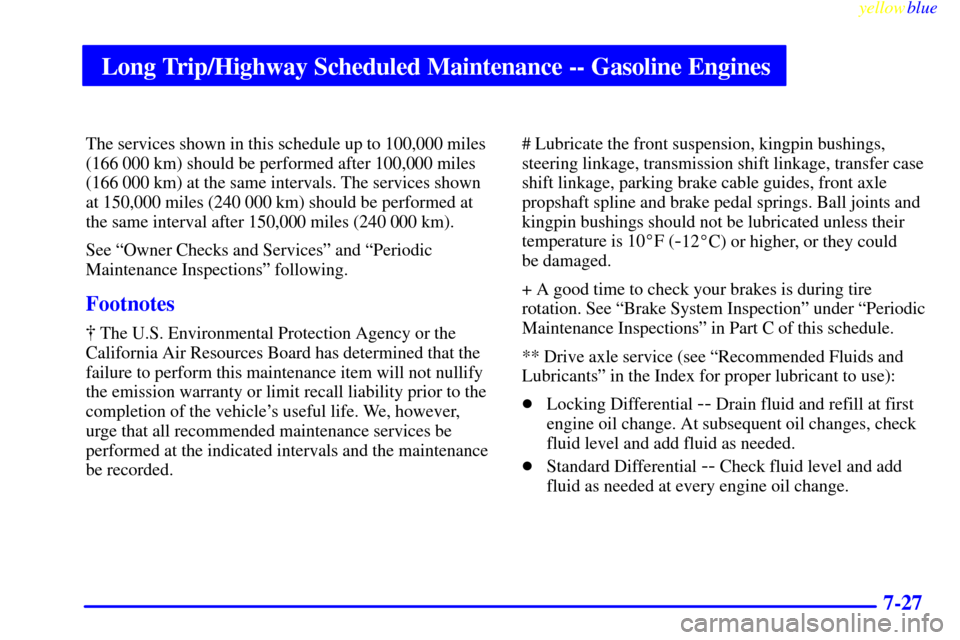Page 319 of 424
yellowblue
6-39 Front Parking/Turn Signal Lamps with
Composite Headlamps
1. Remove the four screws
and take out the
parking/turn signal
lamp assembly.
2. Squeeze the tab on the side of the lamp socket while
turning the socket counterclockwise.
3. Pull the socket out of the
lamp assembly.
4. Push in gently on the bulb, turn it counterclockwise
and remove it from the socket.
5. Put the new bulb into the socket, gently press in on
the bulb and turn it clockwise until it is tight.
6. Put the socket back into the lamp assembly and turn
it clockwise until it locks.
7. Put the parking/turn signal lamp assembly back into
the vehicle and tighten the four screws.
Page 320 of 424
yellowblue
6-40 Sidemarker Lamps with Sealed Beam and
Composite Headlamps
1. Remove the four screws
and pull out the
parking/turn signal
lamp assembly.
2. Reach through the opening and turn the sidemarker
bulb socket counterclockwise and remove it.
3. Pull the bulb straight out
of the socket.
4. Put a new bulb into the socket and push it in until it
is tight.
5. Put the socket back into the sidemarker assembly
and turn it clockwise to tighten it.
6. Replace the parking/turn signal lamp assembly and
tighten the screws.
Page 341 of 424

yellowblue
6-61 Fuses and Circuit Breakers
The wiring circuits in your vehicle are protected from
short circuits by a combination of fuses, circuit breakers
and fusible thermal links in the wiring itself. This
greatly reduces the chance of fires caused by electrical
problems. See ªFuses and Circuit Breakersº in the Index
for more information.
Look at the silver
-colored band inside the fuse. If the
band is broken or melted, replace the fuse. Be sure you
replace a bad fuse with a new one of the identical size
and rating.
If you ever have a problem on the road and don't have a
spare fuse, you can borrow one that has the same
amperage. Just pick some feature of your vehicle that
you can get along without
-- like the radio or cigarette
lighter
-- and use its fuse, if it is the correct amperage.
Replace it as soon as you can.Instrument Panel Fuse Block
The fuse block access door
is on the driver's side edge
of the instrument panel. Pull
off the cover to access the
fuse block.
You can remove fuses with
a fuse extractor. The fuse
extractor is mounted to the
fuse block access door.
To remove fuses, if you don't have a fuse extractor, hold
the end of the fuse between your thumb and index finger
and pull straight out.
You may have spare fuses attached to the inside of
the fuse block access door. These can be used to
replace a bad fuse. However, make sure that it is the
correct amperage.
Page 342 of 424
yellowblue
6-62
Fuse/Circuit
BreakerUsage
1 Stop/TCC Switch, Buzzer, CHMSL,
Hazard Lamps, Stoplamps
2 Transfer Case
3 Courtesy Lamps, Cargo Lamp, Glove
Box Lamp, Dome/Reading Lamps,
Vanity Mirrors, Power MirrorsFuse/Circuit
BreakerUsage
4 Instrument Cluster, DRL Relay, Lamp
Switch, Keyless Entry, Low Coolant
Module, Illuminated Entry Module,
DRAC (Diesel Engine)
5 Rear Comfort Controls
6 Cruise Control
7 Auxiliary Power Outlet
8 Crank
9 License Lamp, Parking Lamps,
Taillamps, Roof Marker Lamps,
Tailgate Lamps, Front Sidemarkers,
Fog Lamp Relay, Door Switch
Illumination, Fender Lamps,
Headlamp Switch Illumination
10 Air Bag System
11 Wiper Motor, Washer Pump
12 A/C, A/C Blower, High Blower Relay
13 Power Amp, Rear Liftglass, Cigarette
Lighter, Door Lock Relay, Power
Lumbar Seat
Page 343 of 424

yellowblue
6-63
Fuse/Circuit
BreakerUsage
14 4WD Indicator, Cluster, Front and
Rear Comfort Controls (If Equipped),
Instrument Switches, Radio
Illumination, Chime Module
15 DRL Relay, Fog Lamp Relay
16 Front and Rear Turn Signals,
Back
-Up Lamps, BTSI Solenoid
17 Radio (Ignition)
18 4WAL/VCM, ABS, Cruise Control
19 Radio (Battery)
20 PRNDL, Automatic Transmission,
Speedometer, Check Gages,
Warning Lights
21 Security/Steering
22 Not Used
23 Rear Wiper, Rear Washer Pump
24 Front Axle, 4WD Indicator Lamp,
TP2 Relay (Gasoline Engine)
A Power Door Lock, Six
-Way Power
Seat, Keyless Entry Module
B Power WindowsUnderhood Fuse/Relay Center
The underhood fuse/relay center is located in the rear of
the engine compartment near the brake fluid reservoir.
Move the retainer clips for the cover to access the
fuse block.
You can remove fuses with a fuse extractor. The fuse
extractor is mounted to the interior fuse block. To
remove fuses if you don't have a fuse extractor, hold the
end of the fuse between your thumb and index finger
and pull straight out.
Page 344 of 424
yellowblue
6-64
Name Circuits Protected
ECM
-B Fuel Pump, PCM/VCM
RR DEFOG Rear Window Defogger
(If Equipped)
IGN
-E Auxiliary Fan Relay Coil, A/C
Compressor Relay, Hot Fuel Module
FUEL SOL Fuel Solenoid (Diesel Engine)
GLOW PLUG Glow plugs (Diesel Engine)
HORN Horn, Underhood LampsName Circuits Protected
AUX FAN Auxiliary Fan
ECM
-1 Injectors, PCM/VCM
HTD ST
-FR Heated Front Seats
A/C Air Conditioning
HTD MIR Heated Outside Mirrors (If Equipped)
ENG
-1 Ignition Switch, EGR, Canister
Purge, EVRV Idle Coast Solenoid,
Heated O
2, Fuel Heater
(Diesel Engine), Water Sensor
(Diesel Engine)
HTD ST
-RR Not Used
LIGHTING Headlamp and Panel Dimmer
Switch, Fog and Courtesy Fuses
BATT Battery, Fuse Block Busbar
IGN
-A Ignition Switch
IGN
-B Ignition Switch
ABS Anti
-Lock Brake Module
BLOWER Hi Blower and Rear Blower Relays
STOP/HAZ Stoplamps
HEATED SEATS Heated Seats (If Equipped)
Page 358 of 424

Short Trip/City Scheduled Maintenance -- Gasoline Engines
yellowblue
7-8
The services shown in this schedule up to 100,000 miles
(166 000 km) should be performed after 100,000 miles
(166 000 km) at the same intervals. The services shown
at 150,000 miles (240 000 km) should be performed at
the same interval after 150,000 miles (240 000 km).
See ªOwner Checks and Servicesº and ªPeriodic
Maintenance Inspectionsº following.
Footnotes
� The U.S. Environmental Protection Agency or the
California Air Resources Board has determined that the
failure to perform this maintenance item will not nullify
the emission warranty or limit recall liability prior to the
completion of the vehicle's useful life. We, however, urge
that all recommended maintenance services be performed
at the indicated intervals and the maintenance be recorded.
# Lubricate the front suspension, kingpin bushings,
steering linkage, transmission shift linkage, transfer case
shift linkage, parking brake cable guides, front axle
propshaft spline and brake pedal springs. Ball joints andkingpin bushings should not be lubricated unless their
temperature is 10�F (
-12�C) or higher, or they could
be damaged.
+ A good time to check your brakes is during tire
rotation. See ªBrake System Inspectionº under ªPeriodic
Maintenance Inspectionsº in Part C of this schedule.
** Drive axle service (see ªRecommended Fluids and
Lubricantsº in the Index for proper lubricant to use):
�Locking Differential
-- Drain fluid and refill at first
engine oil change. At subsequent oil changes, check
fluid level and add fluid as needed. If driving in
dusty areas or towing a trailer, drain fluid and refill
every 15,000 miles (25 000 km).
�Standard Differential
-- Check fluid level and add
fluid as needed at every oil change. If driving in
dusty areas or towing a trailer, drain fluid and refill
every 15,000 miles (25 000 km).
�More frequent lubrication may be required for
heavy
-duty or off-road use.
Page 377 of 424

Long Trip/Highway Scheduled Maintenance -- Gasoline Engines
yellowblue
7-27
The services shown in this schedule up to 100,000 miles
(166 000 km) should be performed after 100,000 miles
(166 000 km) at the same intervals. The services shown
at 150,000 miles (240 000 km) should be performed at
the same interval after 150,000 miles (240 000 km).
See ªOwner Checks and Servicesº and ªPeriodic
Maintenance Inspectionsº following.
Footnotes
� The U.S. Environmental Protection Agency or the
California Air Resources Board has determined that the
failure to perform this maintenance item will not nullify
the emission warranty or limit recall liability prior to the
completion of the vehicle's useful life. We, however,
urge that all recommended maintenance services be
performed at the indicated intervals and the maintenance
be recorded.# Lubricate the front suspension, kingpin bushings,
steering linkage, transmission shift linkage, transfer case
shift linkage, parking brake cable guides, front axle
propshaft spline and brake pedal springs. Ball joints and
kingpin bushings should not be lubricated unless their
temperature is 10�F (
-12�C) or higher, or they could
be damaged.
+ A good time to check your brakes is during tire
rotation. See ªBrake System Inspectionº under ªPeriodic
Maintenance Inspectionsº in Part C of this schedule.
** Drive axle service (see ªRecommended Fluids and
Lubricantsº in the Index for proper lubricant to use):
�Locking Differential
-- Drain fluid and refill at first
engine oil change. At subsequent oil changes, check
fluid level and add fluid as needed.
�Standard Differential
-- Check fluid level and add
fluid as needed at every engine oil change.